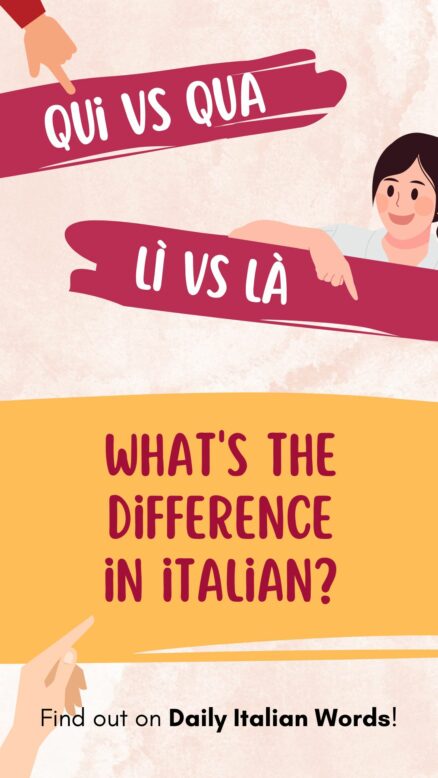In English, we have one adverb of place to describe the location of something close to us – here – and another to describe the location of something further away – there. This is why many learners are surprised to learn that four different adverbs exist in Italian: qui and qua (the equivalents of here) and lì vs là (the equivalents of there).

So what’s the difference between qui/qua and lì/là?
According to Italian grammar books, qui and lì are supposed to indiciate a precise location whereas qua and là are more of an approximation. Examples always help so let’s take a look at a couple now.
Ho messo il libro qui sul tavolo ma ora non c’è più.
I put the book here on the table but now it’s gone.
In this case, the speaker is probably referring to the specific spot she left the book on the table – perhaps at the centre or close to the edge.
Ho messo il libro qua sul tavolo ma ora non c’è più.
I put the book here on the table but now it’s gone.

In this second example, we know she put the book on the table but its exact location hasn’t been specified. In other words, it could have been anywhere on the table.
The same applies to lì and là. By using lì, she is referring to a specific spot on the table, even though she is standing far away from it while talking. Là on the other hand implies that the book could have been anywhere on the table.
Ho messo il libro lì sul tavolo ma ora non c’è più.
I put the book there on the table but now it’s gone.
Ho messo il libro là sul tavolo ma ora non c’è più.
I put the book there on the table but now it’s gone.
What about spoken Italian?
The truth is that in spoken Italian, people often don’t differentiate between qui and qua and lì and là. Put differently, if you used qui / lì in an imprecise phrase or qua / là in a precise phrase, no one would blink an eye.
This is because additional descriptive words and phrases are often included to specify the location of an object. For example:
Ho messo il libro proprio [ qui / qua ]!
I put the book right here!
Ho messo il libro proprio [ lì / là ]!
I put the book right there!

In this case, the word proprio (right, exactly) is doing the job of pinpointing the precise location of the book. However in the next example…
Ho messo il libro [ qui / qua ] da qualche parte.
I put the book somewhere around here.
Ho messo il libro [ lì / là ] da qualche parte.
I put the book somewhere around there.
…the phrase da qualche parte (somewhere, someplace) is enough to tell us that the exact location of the book is unknown.
Italians might instinctively choose one or the other according to how much information the sentence contains about the location of an object. For example:
- Ho messo il libro lì, in quella scatola blu in alto sopra l’armadio. = I put the book there, in that blue box on top of the wardrobe.
- Ho messo il libro là, in una di quelle scatole dentro l’armadio. = I put the book there, in one of those boxes inside the wardrobe.
In the first sentence, the location of the libro is precise: it’s in the blue box on top of the wardrobe. In the second sentence, the location is less precise: the book is inside one of the boxes inside the wardrobe.

Do you have any other questions about qui / qua and lì / là? Let us know in the comments below! 🙂
Heather Broster is a graduate with honours in linguistics from the University of Western Ontario. She is an aspiring polyglot, proficient in English and Italian, as well as Japanese, Welsh, and French to varying degrees of fluency. Originally from Toronto, Heather has resided in various countries, notably Italy for a period of six years. Her primary focus lies in the fields of language acquisition, education, and bilingual instruction.


